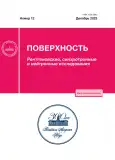Formation of Radiation Defects in Wide-Band Semiconductors Based on Gallium (Ga2O3, GaN) under Proton Irradiation
- Autores: Kozlovski V.V.1, Vasil’ev A.E.1, Lebedev A.A.2, Zhurkin E.E.1, Levinshtein M.E.2, Strelchuk A.M.2
-
Afiliações:
- Peter the Great St. Petersburg Polytechnic University
- Ioffe Institute
- Edição: Nº 12 (2023)
- Páginas: 63-69
- Seção: Articles
- URL: https://journals.rcsi.science/1028-0960/article/view/232220
- DOI: https://doi.org/10.31857/S1028096023120099
- EDN: https://elibrary.ru/BHSYBZ
- ID: 232220
Citar
Texto integral
Resumo
Using mathematical modeling of the displacement cascade in two wide-gap semiconductors based on gallium, gallium oxide (Ga2O3) and gallium nitride (GaN), the features of the generation of Frenkel pairs during the scattering of protons with energies of 8 and 15 MeV are considered. The number of displacements created not only by primary knocked-on atoms, but also by recoil atoms generated in displacement cascades is calculated for the first time. Calculations have shown that under proton irradiation of Ga2O3, for example, the fraction of vacancies in the oxygen sublattice created directly by protons is only 12%. The remaining 88% are created by recoil atoms in cascade processes. For the gallium sublattice, these fractions are 25 and 75%, respectively. Therefore, the processes of compensating the conductivity of GaN and Ga2O3 observed under proton irradiation will be determined by deep centers created not by primary knocked-on atoms, but by recoil atoms formed in displacement cascades. A comparison with experimental data is made, and the fraction of Frenkel pairs dissociating during irradiation is estimated.
Sobre autores
V. Kozlovski
Peter the Great St. Petersburg Polytechnic University
Autor responsável pela correspondência
Email: kozlovski@physics.spbstu.ru
Russia, 195251, St. Petersburg
A. Vasil’ev
Peter the Great St. Petersburg Polytechnic University
Autor responsável pela correspondência
Email: electronych@mail.ru
Russia, 195251, St. Petersburg
A. Lebedev
Ioffe Institute
Autor responsável pela correspondência
Email: shura.lebe@mail.ioffe.ru
Russia, 194021, St. Petersburg
E. Zhurkin
Peter the Great St. Petersburg Polytechnic University
Autor responsável pela correspondência
Email: ezhurkin@phmf.spbstu.ru
Russia, 195251, St. Petersburg
M. Levinshtein
Ioffe Institute
Autor responsável pela correspondência
Email: melev@nimis.ioffe.ru
Russia, 194021, St. Petersburg
A. Strelchuk
Ioffe Institute
Autor responsável pela correspondência
Email: anatoly.strelchuk@mail.ioffe.ru
Russia, 194021, St. Petersburg
Bibliografia
- Kozlovski V., Abrosimova V. Radiation Defect Engineering. Selected Topics in Electronics and Systems V. 37. Singapore: World Scientific, 2005. 264 p.
- Claeys C., Simoen E. Radiation Effects in Advanced Semiconductor Materials and Devices. Berlin: Springer–Verlag, 2002. 401 p.
- Strokan N.B., Ivanov A.M., Savkina N.S. et al. // Semiconductors. 2004. V. 38. P. 807.
- Van Lint V.A.J. Mechanisms of Radiation Effects in Electronic Materials. John Wiley & Sons, 1980.
- Козловский В.В., Васильев А.Э., Лебедев А.А. // Поверхность. Рентген., синхротр. и нейтрон. исслед. 2016. № 7. С. 19.
- Козловский В.В., Васильев А.Э., Карасев П.А., Лебедев А.А. // Физика и техника полупроводников. 2018. Т. 52. № 3. С. 327.
- SRIM-2013 Software Package. http://www.srim.org https://doi.org/10.1007/978-1-4615-8103-1_3
- Ziegler J.F., Biersack J.P., Littmark U. The Stopping and Range of Ions in Matter. New York: Pergamon, 1985.
- Steeds J.W., Carosella F., Evans G.A. et al. // Mater. Sci. Forum. 2001. V. 353–356. P. 381.
- Steeds J.W., Evans G.A., Furkert S. et al. // Diamond Related Mater. 2002. V. 11. P. 1923.
- Lebedev A.A. Radiation Effects in Silicon Carbide // Materials Research Forum LLC, Millersville, USA, 2017. V. 6. PA 17551.
- Pons D., Bourgoin J.C. // J. Phys. C. 1985. V. 18. P. 3839.
- Barry A.L., Maxseiner R., Wojcik R. et al. // IEEE Trans. Nucl. Sci. 1990. V. 37. № 6. P. 1726.
- Look D.C., Reynolds D.C., Hemsky J.W. et al. // Phys. Rev. Lett. 1997. V. 79. P. 2273.
- Ionascut-Nedelcescu A., Carlone C., Houdayer A., von Bardeleben H.J., Cantin J.-L., Raymond S. // IEEE Trans. Nucl. Sci. 2002. V. 49. P. 2733.
- Emtsev V.V., Davydov V.Yu., Emtsev K.V., Poloskin D.S., Oganesyan G.A., Kozlovski V.V., Haller E.E. // Phys. Stat. Sol. C. 2003. № 2. P. 601.
- Pearton S.J., Ren F., Patrick E., Law M.E., Polyakov A.Y. // ECS J. Solid State Sci. Technol. 2016. V. 5. P. Q35.
- Bardeleben H.J., Zhou S., Gerstmann U. et al. // APL Mater. 2019. V. 7. P. 022521.
- Kim J., Pearton S.J., Fares C. et al. // J. Mater. Chem. C. 2019. V. 7. P. 10.
- Farzana E., Chaiken M.F., Blue T.E. et al. // APL Mater. 2019. V. 7. P. 022502.
- Лебедев А.А., Белов С.В., Мынбаева М.Г. и др. // Физика и техника полупроводников. 2015. Т. 49. Вып. 10. С. 1386.
- Lebedev A.A., Belov S.V., Mynbayeva M.G. et al. // Mater. Sci. Forum. 2016. V. 858. P. 1186.
- Yang J., Chen Z., Ren F. et al. // J. Vac. Sci. Technol. B. 2018. V. 36. № 1. P. 011206.
- Polyakov A.Y., Smirnov N.B., Shchemerov I.V. et al. // Appl. Phys. Lett. 2018. V. 113. P. 092102.
- Karmarkar A.P., White B.D., Buttari D., Fleetwood D.M., Schrimpf R.D., Weller R.A., Brillson L.J., Mishra U.K. // IEEE Trans. Nucl. Sci. 2005. V. 52. P. 2239.
- Auret F.D., Goodman S.A., Hayes M., Legodi M.J., Hullavarad S.S., Friedland E., Beaumont B., Gibart P. // Nucl. Instrum. Methods Phys. Res. B. 2001. V. 175–177. P. 292.
- Козловский В.В., Васильев А.Э., Емцев В.В., Оганесян Г.А., Лебедев А.А. // Поверхность. Рентген., синхротр. и нейтрон. исслед. 2019. № 12. С. 20.
- Pearton S.J., Ren F., Mastro M. Gallium Oxide. Technology, Devices and Applications. Elsevier, 2019.
Arquivos suplementares











